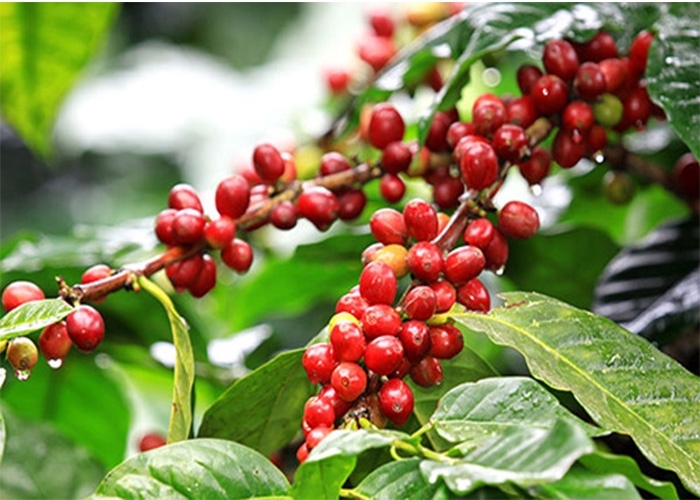Vietnam coffee market update mid-June 2024
Saturday, June 22,2024
AsemconnectVietnam - Coffee exports are expected to reach an estimated 2.9 billion USD in the first five months of this year, representing a rise of 43.9% over the same period last year on rising prices despite a drop of 3.9% in volume to 833,000 tonnes, according to the Ministry of Agriculture and Rural Development.
Coffee exports are expected to reach an estimated 2.9 billion USD in the first five months of this year, representing a rise of 43.9% over the same period last year on rising prices despite a drop of 3.9% in volume to 833,000 tonnes, according to the Ministry of Agriculture and Rural Development.Coffee export prices averaged 4,208 USD per tonne in May, 11.7% higher than April and 63.6% higher than May 2023. Prices averaged 3,428 USD per tonne from January through May, up 49.9% over the same period last year.
Despite impressive export value growth, Vietnam’s coffee industry is facing a drop in output for export due to prolonged heat and drought.
Since the beginning of the crop season in October 2023, Vietnam has exported more than 1.2 million tonnes of coffee, meaning that inventory is low while prices remain high.
The Vietnam Coffee Association (Vicofa) predicted that Vietnam’s coffee exports might fall by 20% in the 2023-24 crop season to 1.336 million tonnes.
Drought reduces Vietnam's coffee output
The El-Nino caused high temperatures and reduced rainfall has severely impacted Vietnam's coffee farming and looms to decrease its output drastically this year.
Coffee farmers of the world's second-largest coffee exporter have expanded their planting areas with rising international coffee prices in recent years. But the extreme weather has dealt them a heavy blow.
In Gia Lai Province, a major coffee producer in Vietnam, numerous local farmers are upset by the ongoing drought.
Currently, local farmers are only able to increase irrigation to mitigate the impact of extreme weather on the coffee production, with little effect. Meteorologists noted that Vietnamese coffee strains are sensitive to temperatures and highly vulnerable to extreme weather conditions.
Coffee output in 2023-2024 crop forecast to fall 20%
The Ministry of Agriculture and Rural Development said that Vietnam’s coffee output in the 2023–2024 crop year is estimated to decrease by 20% compared to the previous crop year, to 1.47 million tonnes, the lowest in four years, putting pressure on Robusta supply in the world market.
Due to the impact of climate change, the dry season comes earlier than usual in Vietnam, and prolonged hot weather causes water levels at dams in some provinces to rapidly decrease. Fears that drought could affect crops have caused domestic coffee prices to increase sharply in the past week.
Over the past years, coffee prices were low, prompting many farmers to gradually switch to higher value crops. However, this year’s coffee prices are experiencing a record high, and it’s expected to be an opportunity to motivate farmers to restore coffee growing area.
Increasing the value of coffee plants
As one of Vietnam’s key crops, coffee has helped create jobs and stable incomes for farmers in many provinces. Today, local authorities and farmers are stepping up the application of science in production to create high-quality products for domestic consumption and export.
According to Nguyen Quoc Manh, Deputy Director of the Department of Crop Production under the Ministry of Agriculture and Rural Development (MARD), the total coffee growing area in Vietnam was 715,300 hectares as of 2023, producing 1.89 million tonnes of coffee beans.
Coffee is now a key crop in many localities, creating stable jobs for more than one million workers.
Vietnamese coffee has also affirmed its brand and value with its presence in many markets. In 2023, Vietnam’s coffee export volume reached 1.623 million tonnes, with revenue of 4.24 billion USD, the highest figure in the past ten years.
With a view for sustainable development and enhancing the value of coffee, many localities have developed cultivation zones employing advanced technologies such as planting new cultivars, combining drip irrigation and fertilisation, measuring the content of sugar in ripen coffee beans, and using internet-based automatic weather monitoring systems to access data for production.
Dak Lak Province has 212,000 hectares of coffee, which has been determined as a key crop. Coffee is currently earning a high selling price, helping to raise the income of farmers.
Under a plan to develop key industrial-use crops until 2030, MARD aims to raise the total coffee cultivation area to 640,000-660,000 hectares, with a coffee bean output of 1.8-2 million tonnes. The Central Highlands region will account for 600,000 hectares, while the remaining 40,000-60,000 hectares are distributed in the provinces of Binh Phuoc, Dong Nai, Ba Ria-Vung Tau, Son La, Quang Tri and Binh Thuan. Robusta coffee accounts for about 90-92% and arabica coffee makes up 8-10%.
T.Huong
Source: Vitic
Vietnam shrimp market update mid-June 2024
Vietnam textile and garment market update mid-June 2024
DAILY: Vietnamese pepper prices remained unchanged on June 21, 2024
DAILY: Vietnamese coffee prices increased by 2000 VND on June,21 2024
Vietnam's exports of goods to key markets in first 5 months of 2024
"Bright door" for export to Asia - Africa markets
Vietnam rice market update mid-June 2024
Vietnam seafood market update mid-June 2024
Vietnam fruit market update mid-June 2024
Vietnam steel market update mid-June 2024
DAILY: Vietnamese pepper prices decreased by 1000-2000 VND on June 20, 2024
DAILY: Vietnamese coffee prices increased by 1000 VND on June,20 2024
Exports up 13.8% in first half: ministry
Vietnam Energy Outlook Report 2024 launched


